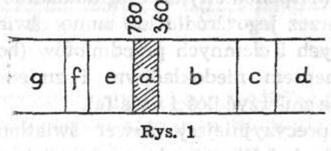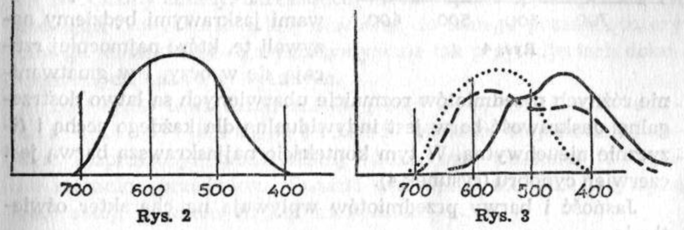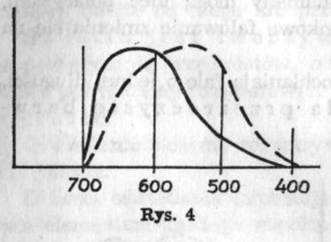Light is electromagnetic energy, radiant, undulating transversely to the direction of propagation. It has less than a speed in a vacuum 300000 km/sek. Passing through a transparent body (optical medium) slows down its run, maintaining a constant speed, to speed it up after leaving the facility with a new speed, which is again a constant quantity.

Light is the radiation of electromagnetic waves, visible to the human eye. The wavelength of visible light is approximately between 360 square meter (extreme violet) do 780 square meter (extreme purple). It is variable to some extent depending on the individual abilities of a person, on the lighting conditions and on the mental attitude of the person looking (lynx. 1, a).
In the direction of longer and shorter wavelengths there are zones of invisible radiation, one side ultraviolet (b), x-rays (c) and gamma rays (d), with druhey - infrared rays (e), Hertz (f) and finally radio (g) short, medium and long. (In the drawing 1 we see, that visible light is only a small part of the scale of electromagnetic radiation).
We can only photograph such an object, from which rays of light produced by this object run to the camera lens or, what happens most often in photography, reflected from it or transmitted through it.
Light is the material of lighting. Falling on the surface of objects, it illuminates it so that we can see it and we can photograph it. Light determines photography.
We can consider lighting in two ways: in terms of quantity and quality.
The photocell informs us about the amount of lighting, which is an active element of every modern light meter. On the other hand, qualitative lighting depends on the nature of the incident light (mostly independent of the amount of light) and from its direction of incidence on the surface of the illuminated object.
Light meter (exposuremeter) defines exactly the intensity of the light emitted by its source or the sum of the light, reflected from the surface of light and dark objects (for the human eye is an inaccurate and variable instrument, and is unable to accurately measure the quantity of light).
However, even the most precise light meter cannot determine, whether it is unscattered or diffused light, front, side or top and will not specify, whether the shadows are properly or incorrectly arranged on the surface of the photographed object. Only the human eye has this ability, so man. Therefore, only a human being can consider lighting issues from the qualitative side.
Light, encountering a material object on the way, can be absorbed by this item, reflected, passed, bent, polarized. As a result of the reduction of the speed of the ray in the optical medium, the rays incident obliquely on the boundary between the vacuum and the medium or between two different optical mediums are refracted.
The transmitted or reflected light may be scattered depending on the nature of the matter of the transmitting medium or the nature of the surface of the transmitting medium, as well as the reflector. Refracted or diffracted light is split into the basic colors of the spectrum.
The reflected ray and the refracted ray can be polarized, being primary, multi-directional undulation changes to uni-directional.
Some transparent bodies absorb only one wavelength, letting others through. They are transparent colored bodies.

Opaque objects can also reflect rays of a certain wavelength, devouring others. They are a group of opaque-colored bodies.
Any wavelength of light in the range of 360 mµ do 780 mµ is perceived by the human eye as a different color. A mixture of several different waves gives the eye a resultant color, different from the components. The mixture of all wavelengths of the solar spectrum gives the impression of white. For example: a mixture of orange and green rays gives the impression of yellow.
Photographic materials may have different sensitivities to the range of light, reach in some cases 280 square meter (ultraviolet sensitized emulsions), in others to 800 mµ and more ("infrared" emulsions).
The human eye sees yellow with a greenish tint the brightest, other colors are perceived as darker. (This relationship is shown in the figure 2). On the other hand, photographic materials reproduce the brightness of individual colors slightly differently (drawing 3; dotted line - sensitivity of the human eye, hatched - superpanchromatic film sensitivity, continuous - orthopanchromatic membrane). This often makes it necessary to use filters, and what we are particularly interested in, adequate lighting.
For our eye, except brightness, colors have certain characteristics, which we can call brightness. We will call these bright colors, which are most conspicuous, and in the tangle of various objects of various colors are easily discernible. The brightness of colors is an individual feature and physically elusive. In this context, the brightest color is cinnabar red (drawing 4).

The brightness and colors of objects affect the nature of lighting.
Light intensity is measured with photometers. It is dependent: from the brightness of the light source, on its distance from the object and on the degree of absorption of light by this object. A photographic light meter is nothing more than a photometer adapted to calculate the light intensity needed to properly expose a photo. It only measures the total amount of light reaching the object. The light meter, however, is of little use for determining the quality of lighting.
It is almost exclusively the experienced eye of the photographer that decides here, which evaluates the brightness of individual elements of the object and compares them. The purpose of this book is to provide structured information about qualitative lighting.
There are few lighting rules, but by combining the basic elements, we get hundreds of thousands of different cases. That is why we will not give "recipes" for lighting, but we will give general rules, that the photographer can use.
From the side of the photographic workshop, we distinguish two different types of lighting, rather, two methods of lighting. One of them is going: — to present the photographed object as objectively as possible, — to emphasize the spatial shape of the object, and — to reproduce the character of its surface and its own tonality. Eigentonality is the brightness of the surface of an object independent of the illumination. Example: the white sheet has a bright tonality of its own; coal - dark own tonality.
The second is to convey the mood desired by the photographer, atmosphere of the picture, even at the cost of deforming the features of the object and reducing its legibility.
We don't know the rule, defining infallibly, which of the two types of lighting should be used for which subject or subject. Both are used for documentary photos, as well as artistic.
The lighting result consists of: the direction of light and the degree of light diffusion. Most often, we emphasize the objective textural and tonal properties of the object with diffused light. Unscattered light is the cause of conscious or unconscious deformations.
The use of non-diffused light correctly reproduces the spatiality of solids with sharp edges, while it distorts the forms of round solids, like a bullet, cylinder or cone, because due to the shortening of the penumbra zone, makes them similar to planar solids with slightly rounded edges. With an oblique direction of incidence, this lighting particularly emphasizes certain types of surface structure, e.g. granular structure.
Diffused lighting loses the spatiality of the object, especially shapes with sharp edges, while in the lateral direction of incidence of the rays, correctly shapes solids with rounded surfaces. Diffused lighting does not distort the tonality of spatial objects, but loses their lumpy character.
Therefore, the use of appropriate lighting is conditioned:
1. spatial shape of the photographed object, (The spatial shape is the "depth" of an object depending on its height and width. The spatial shape can be deep or shallow. It changes depending on the direction, from which we observe the object and the distance of this object from the observer. Example: the brick seen from its smallest wall has a deep shape, from the largest side - tiles. Another example: the building viewed from its corner edge from a great distance is shallow, up close - deep. Depth image of items, his drawing results from the laws of painting perspective.)
2. its spatial nature, (The spatial character results from the geometric structure of the photographed object. It can be sharp with planar figures, such as a cube, and rounded in figures of revolution.)
3. features of its own tonality,
4. type of its surface,
5. assumptions, set by the photographer.
For example, we have given some ways of lighting. In practice, there are many more. New issues arise every time before the photographer, just for this reason, that he photographs an infinite number of different shapes, adapting them to the appropriate lighting each time.
Despite these difficulties, although each lighting has its positives and negatives, we have the ability to realize any reasonably successful lighting.